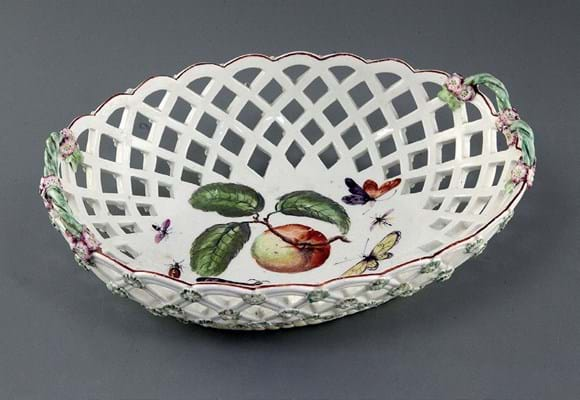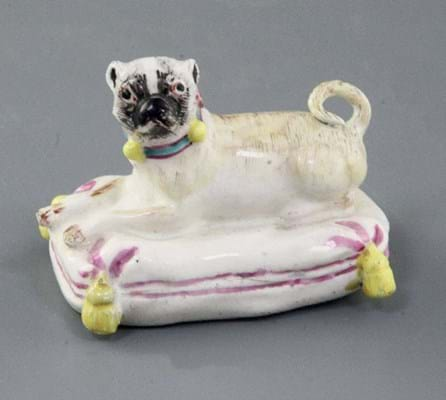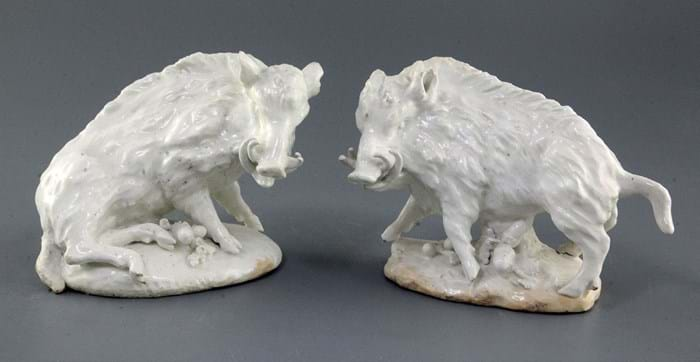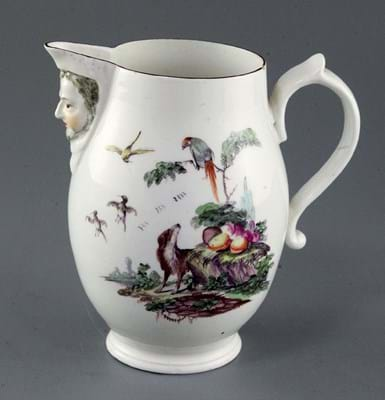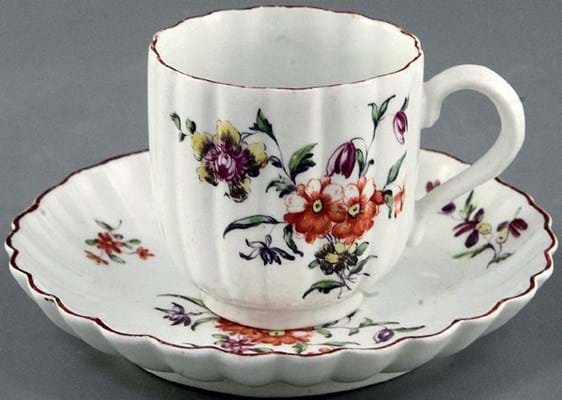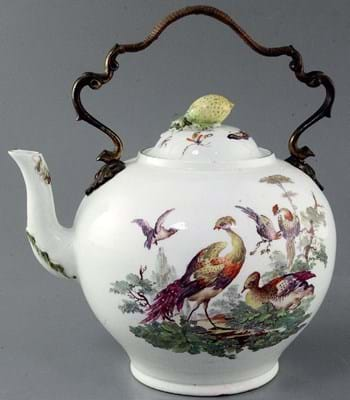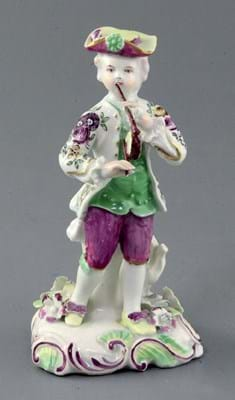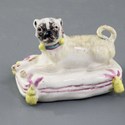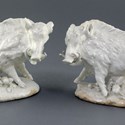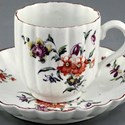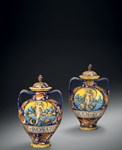A medical practitioner by profession who combined an inquisitive brain with an acquisitive nature, his quest to unravel the chronology of early Derby wares spanned half a century and countless purchases from leading London and regional specialist dealers.
His legacy is the book Derby Porcelain: The Golden Years, 1750-70, published in 1983 – and a £100,000 sale of 163 lots held at Gorringe’s (21% buyer’s premium) in Lewes on March 12.
The earliest figures made in Derby are the so-called ‘dry-edge’ wares from the period c.1750-55 associated with the Huguenot emigré Andrew Planché (c.1727-1805) and, as more recent scholarship has shown, the Italian-born sculptor Agostino Carlini (1718-90).
Among the best-known models are a pair of boars, one modelled seated after Pietro Tacca, the other trotting with a tree stump support. Rice had bought his white-glazed pair from Eastbourne dealer Winifred Williams in 1979 for £1250. Despite yellowing restoration and browning to the glaze, they took £6000 at Gorringe’s. An unusual feature to one was the incised initials IW – an enigmatic mark it shared with a similar model of a long-horned goat sold as part of Lord Kenneth Clark’s collection by Sotheby’s in November 2014 (£4000).
Specialist Dan Bray observed these white figures garnered more international appeal than the Compass factory figures that gave the collection its ‘wow’ factor (see front page).
A pair of figures of a ram and ewe – the ewe bought from Stockspring Antiques in 1991 for £750 and the ram from Simon Spero in 2002 for £3500 – took £3000. A single figure of a lamb bought from Stockspring Antiques in 2009 for £1680 took £1800.
Dated to c.1755 was a 3in (7cm) polychrome model of a pug recumbent on a pink and yellowtasselled cushion. It shares some characteristics with the Compass factory figures, although the paste has escaped their distinctive black fritting. Estimated at £300-500, it took £5000 – much more than the £950 it had cost from Stockspring Antiques in 2006.
Specialist Dan Bray observed these white figures garnered more international appeal then the Compass factory figures that gave the collection its ‘wow’ factor
A figure of a goldfinch, one of the first Derby bird models c.1756, was estimated at £150-250 but took £800. In his book Rice speculates that this damaged but unrecorded model (bought from Bryan Bowden in 1979 for £450) may have been made in the ‘dry-edge’ period but decorated a few years later after William Duesbury (1725-86) took a share in the Derby enterprise in 1756 and established the Nottingham Road factory.
Much of the terminology surrounding early Derby porcelain is simply descriptive – referencing the dry or unglazed bases, the distinctive ‘patch marks’ acquired during the firing of the glaze or the pale pastel colours common to the first years of Duesbery’s tenure.
The ‘pale family’ figures c.1756-58 were generally well received.
A figure playing a pipe and small drum, wearing a floral coat, on a flower encrusted scrollwork base, made £950 and a pair of large 10in (25cm) figures of a gentleman with a basket of plums and his companion holding a garland of flowers, c.1758 sold at £2200. They had cost, respectively, £1400 from Simon Spero in 2007 and £3200 at Stockspring Antiques in 1991.
It was Duesbury’s development of a new porcelain body containing glass frit, soapstone and calcined bone, that enabled the Derby factory to begin producing the high-quality tableware for which it is still known. Rice owned many pieces with exotic bird decoration from c.1760-65 - including an impressive 11in (27cm) punch kettle with lemon sprig finial and original wicker bound ormolu-arched handle secured with retaining bolts.
A rare bird
Sold at auction house King and Chasemore in 1977 for £730 and bought later that year from Delomosne & Son for £950, this piece may well be the one described by Lady Charlotte Schreiber in the first volume of her journals Confidences of a Collector of Ceramics & Antiques.
During a visit to Mr Hodges in Lyme on September 15, 1869, she noted “a Chelsea tea kettle (I should think unique) painted in birds”. With only minor losses, it sold at £4000.
A teapot and cover with fancy bird decoration (a rare form as Derby teapots from this period were liable to crack through heat shock) sold at £700 (£100 less than it had cost at Delomosne in 1981) while an unusual cylindrical mug sold at £650 (it had cost £480 at Albert Amor in 1980).
As with most types of English porcelain, it is the earliest Derby that now fares best in the market.
The survival of original receipts from a range of well-known London and regional porcelain dealers – painstakingly matched piece by piece by Bray – showed just how much the market has fallen for some Derby wares – particularly those from the second and third decade of production.
Collecting opportunity
With estimates deliberately pitched at attractive levels to open the field to those outside the dwindling number of dedicated Derby collectors, it was a great opportunity to buy published, textbook wares with provenance.
Good examples were an ovoid shaped mask jug painted with a dog standing by a rock and exotic birds (rim chip) sold at £280 (in 1982 it had cost £558 at Delomosne) or a large baluster-shaped mug painted with a chicken and a peacock in a landscape and to the reverse with a bouquet of flowers by the so-called ‘Cotton-stem painter’, bought from E& H Manners in 1988 for £725 but sold at £260.
Buying until 2014, many of Rice’s later purchases focused on domestic wares by this anonymous but talented decorator. Derby coffee cups are uncommon from this early period (and the saucers are especially rare) but there were many examples, typically sold for prices between £150-250. A ribbed coffee cup and saucer painted with a bouquet of flowers and floral sprays, bought at Mercury Antiques 1998 for £1050, took £320.
The history of the Derby factory wasn’t enough to sate Rice’s appetite.
Currently in a dozen packing cases is his collection of Rockingham porcelain and porcelain animals by a range of different factories that spawned several reference books. They will be sold by Gorringe’s in June.


